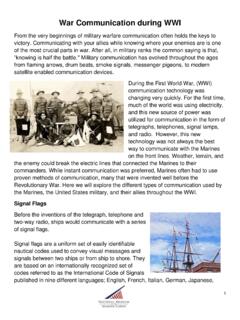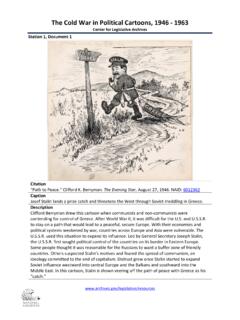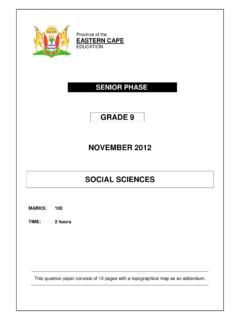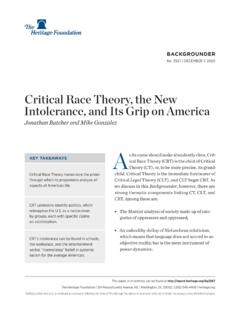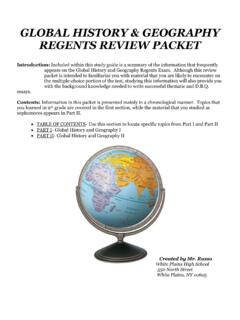Transcription of KOREAN WAR TIMELINE - National Museum of the Marine …
1 KOREAN WAR TIMELINE September 1945 - One of the penalties imposed on Japan at the end of World War II was the loss of Korea. A precursor of the causes of this mid-century KOREAN War was the decision to divide (rather than unify) Korea along the 38th parallel. Soviet Union controlled the north as a result of entering the war against Japan during the last days of World War II and the United States the southern half of the peninsular. 1 October 1949 Mao Ze Dung and his communists People's Republic of China was established after Chiang Kai-shek evacuated from the mainland to the island of Taiwan. 13 January 1950 - Jacob Malik, the Soviet representative to the United Nations, storms out of a meeting of the UN Security Council after the Security Council votes down to replace Chaing Kai Chek s Nationalists Chinese representatives with Representatives of Mao Ze Dung s Peoples Republic of China. This event begins a Soviet Boycott of the United Nations Security Council.
2 25 June 1950 - United Nations Security Council called into emergency session. Soviet Union boycotts session due to permanent seating of Taiwan representing China instead of Communist mainland government. In Soviet absence and their veto power not in effect, Council Resolution 82 passed demanding that North Korea end invasion. This legitimized United Nations actions and the most dramatic of the early events in the pantheon of KOREAN War facts. 27 June 1950 - UN passes Resolution 83 finding North Korea violated the peace and demanded that their forces return to north of the 38th parallel. Soviets absent for the vote so cannot block it in the Security Council. 30 June 1950 President Truman commits American Military Forces to South Korea as the majority military force along with other countries in a coalition military. 7 July 1950 - UN passes Resolution 84 requesting member nations to supply troops to join a military action under a commander.
3 16 nations comply and mission known as a police action . General Douglas McArthur takes command on following day. 4 August 18 September 1950 - North KOREAN troops drove and ROK forces to southeastern corner of South Korea and established a defensive position about the port of Pusan and known as the Pusan perimeter. 15 September 1950 - General McArthur constructed a daring plan to rescue the defenders of Pusan and cut N. KOREAN supply lines. His Marine troops made an amphibious landing at the port of Inchon, drove inland creating a pincer movement with a counter attacking Pusan force that destroyed the North KOREAN army. 29-30 September 1950 - UN forces recapture Seoul and drive north. Washington authorizes General McArthur to cross northward over the 38th parallel. Chinese premier Zhou Enlai warns Washington that China will intervene in the event UN forces cross 38th parallel. 7 October 1950 - UN forces cross 38th parallel. 14-15 October 1950 - Chinese troops respond to UN crossing 38th parallel and enter North Korea crossing international boundary, Yalu River.
4 Chinese refer to their soldiers as volunteers . Almost simultaneously with Chinese crossing into N. Korea, General McArthur met with President Truman on Wake Island to report on the progress of the war and assured Truman that Chinese would not intervene. There appeared to be a meeting of the minds which would unravel by April. 24 November 1950 - McArthur orders a bold offense intending UN troops to drive to the Yalu River and tells his troops they will be, home for Christmas . Chinese troops effect an ambush and drive is a disaster including surrounding thousands and US Marines and Soldiers near the Chosin Reservior. Over the next three weeks US Marines and Soldiers would first defend their positions and then conduct offensive actions to retreat out of the area toward escape to the sea which would be go into the legends of military history, especially within the Marine Corps. Jan 1951 - Chinese capture Seoul. Ultimately retaken by UN March 18.
5 The offensives undertaken by the belligerents underscore a stalemate which was, nevertheless, deadly in terms of casualties. 11 April 1951 - McArthur increasingly at odds with Truman over strategies. The general publicly declaring a desire to blockade Chinese coast and bomb their mainland. Truman fearful that this would invite Soviet entry into the war. A potential prelude to World War III. Truman recalls and removes McArthur from command and asserts civilian control over the military. Appoints General Matthew Ridgeway as replacement. 10 July 1951 - Belligerents forces face each other over the 38th parallel and first truce talks at Kaesong, N. Korea, a city located on the 38th parallel. Talks fail although they agree on agenda. 23 September 1951 - UN forces advance several miles north of 38th parallel and engage North KOREAN forces over 3 week period and take Heartbreak Ridge and Start of Operation Summit (First Helicopter Deployment). 27 Nov 1951 - April 1952 - New truce talks commence in tents at Panmunjom, North Korea.
6 Parties agreed on truce line, 38th parallel, but could not agree on nature of prisoner exchange. Both sides relatively inactive during heavy winter weather, and casualties commensurately reduced. June-July 1952 - Both sides had utilized the prior relative winter calm to strengthen their positions and engaged in fierce artillery battles and limited outpost skirmishes. August-Sept 1952 - The battle for hills and ridges began a new aspect to the war. The control of the mountainous redoubts was considered a first line of defense for each side. Battles were inconclusive with control changing hands constantly. Although limited in scope, casualties weighed heavily on American leaders. Major battles include Battle of Bunker Hill and Hill 122 which saw the first Major Marine Combat in Western Korea, and on 29 August the UN launched the war s largest air raid of over 1,4000 Sorties flown. 14 Oct 1952 - In an effort to convince the Chinese of their intentions to prosecute the war, Americans mounted large offensive to take Triangle Hill, but were unsuccessful after heavy casualties on both sides.
7 Thereafter, the sides retired to their winter positions and repeated the 1951 scenario. Jan 1953 - Dwight Eisenhower elected president after campaigning to conclude the war. Nevertheless, communist leaders were fearful that this election might signal a hard line to continue the war. March 1953 - joseph Stalin dies shifting Soviet s position on the war. 26 April 1953 - Negotiators return to Panmunjom and Communists agree to voluntary repatriation. May 1953 - Communist forces commence new attacks hoping that additional territorial gains would strengthen their positions in the final armistice terms. June 1953 - While the negotiators hammered out details of the agreement, Communist forces commenced a new offensive attaining several miles of new territory. Historians look at this KOREAN War fact and believe these last minute actions were meant to bolster a history of communist victories. In response the Navy and Marine Corps aircraft fly 910 Sorties (Highest single day total on June 15) and the air forces destroy 16 MIG's (Largest single day total on June 26th).
8 6 July 1953 - A last communist successful offensive to dislodge Americans from a hill outpost called Old Baldy . 27 July 1953 - Signing of Armistice (US, Korea and China) ending the KOREAN War (No treaty signed between North and South Korea). A BRIEF SUMMARY OF THE EVENTS DEFENSE AT BREAKOUT OF CHOSIN RESERVOIR Following the successful Inchon landing, forces had North KOREAN troops on the run, but communist China's unexpected entry into the KOREAN War threatened that progress. At Chosin Reservoir, the 1st Marine Division found itself surrounded and outnumbered 8 to 1 by the Chinese army. The worst weather in 50 years cut off air support and assaulted the Marines with snow, wind and temperatures of 40 degrees F. Even so, the "Chosin Few," as they would come to be called, decimated 10 Chinese infantry divisions and fought their way back to the sea to rejoin the American forces. No Marines have ever faced worse weather, terrain or odds than those who fought at Chosin Reservoir, but to anyone familiar with the Marines' spirit of determination, there was no doubt the 1st Marine Division would prevail.
9 Lieutenant Colonel Thomas L. Ridge, commander of 3rd Battalion, 1st Marines (3/1), predicted the Chinese attack would come on the night of 28 November. Almost everyone, including rear support units with little combat training, was pressed into the front line due to the manpower shortage, and the entire perimeter was on full alert by 21:30. It was not long before the Peoples Volunteer Army (PVA) 173rd Regiment attacked the western and the southern perimeter, while the 172nd Regiment struck the hills on the northern perimeter. Despite the preparations, the understrength garrison was overwhelmed, with the Chinese opening several gaps in the defenses and reaching the rear areas. The resulting chaos, however, caused a breakdown in discipline among the Chinese soldiers, who began looting food and clothing instead of exploiting the situation. The defending Americans managed to destroy the Chinese forces in counterattacks, while a breakdown of communications between the Chinese regiments allowed the gaps to close.
10 When the fighting stopped, the Chinese had only gained the East Hill on the northern perimeter. Another attack was planned for the night of 29 November, but air raids by VMF 542 broke up the Chinese formations before it could be carried out. Given the critical manpower shortage at Hagaru ri, Smith ordered a task force to be sent north from Koto ri to open the road south of Hagaru ri. In response, a task force was formed with 921 troops from the 41 Royal Marine Commando, G Company of the 1st Marines and B Company of the 31st Infantry. The task force was dubbed "Task Force Drysdale" after its commander Lieutenant Colonel Douglas B. Drysdale, who also commanded 41 Commando. On the afternoon of 29 November, Task Force Drysdale pushed north from Koto ri while under constant attack from the PVA 60th Division. The task force's harrowing experience later earned the road the nickname "Hell Fire Valley". As the Chinese attacks dragged on, the task force became disorganized, and a destroyed truck in the convoy later split the task force into two segments.

